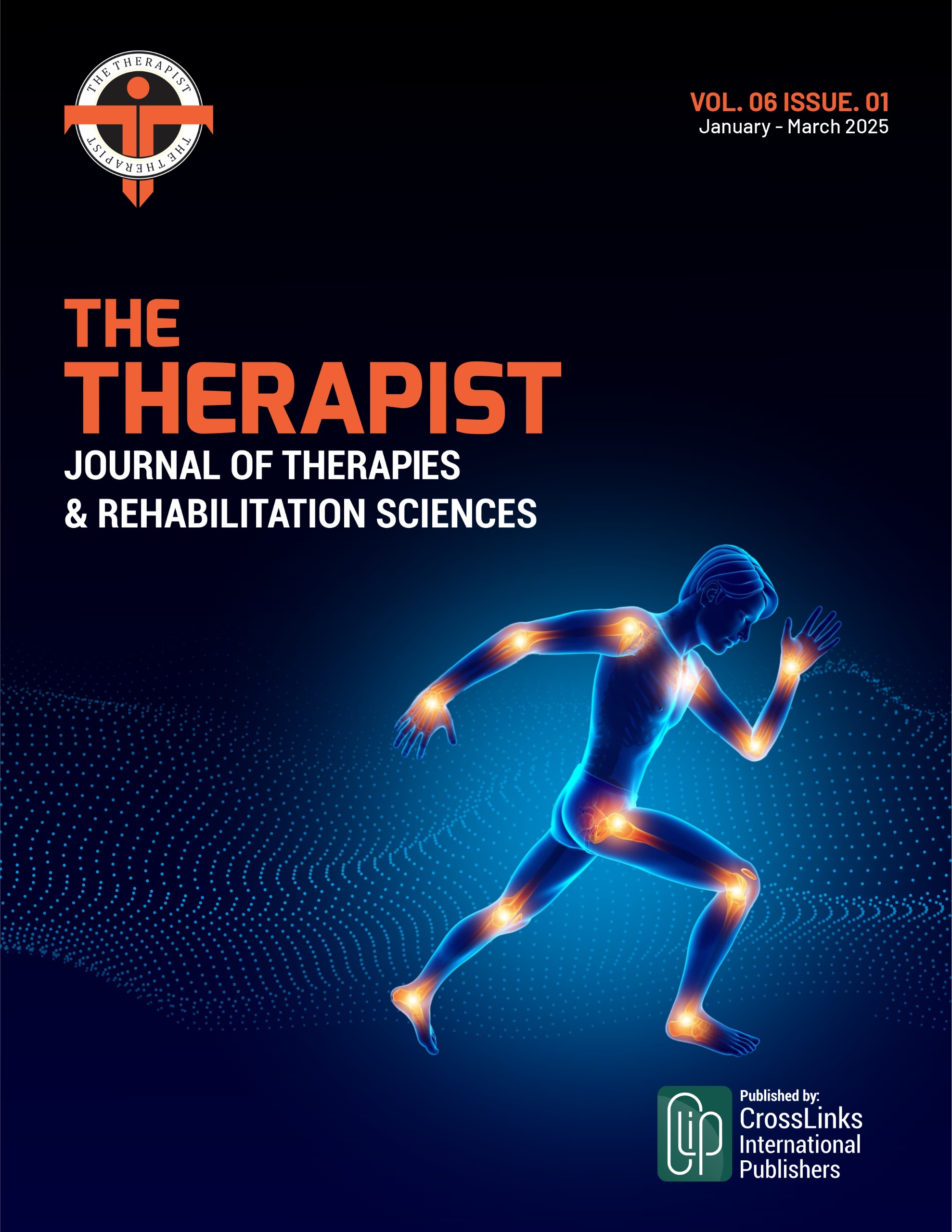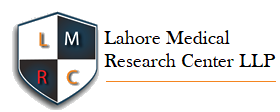Prevalence of Scapulocostal Syndrome in Healthcare Professionals
Scapulocostal Syndrome in Healthcare Professionals
DOI:
https://doi.org/10.54393/tt.v6i1.257Keywords:
Scapulocostal Syndrome, Healthcare Professionals, Musculoskeletal Disorders, Scapular Pain and Posture-Related PainAbstract
Scapulocostal syndrome is a musculoskeletal condition characterized by pain and dysfunction between the scapula and rib cage. It is particularly prevalent among healthcare professionals due to repetitive movements, poor posture, and prolonged static positions during patient care. Objective: To determine the prevalence of scapulocostal syndrome in healthcare professionals. Methods: It was a cross-sectional study design. A sample size of 286 was selected. The Numerical Pain Rating Scale (NPRS) and Pressure Pain Threshold (PPT) are used to assess pain. SPSS version 26.0 was used for data analysis. Functional disability was checked by using the DASH scale. PPT and trigger point palpation were used exclusively for diagnostic confirmation of SCS (per Simons' criteria) and participant eligibility. Results: The study involved 286 participants aged 25 to 45 years, with a majority being female (55.9%). The mean height was 1.69 ± 0.09 m, and the mean weight was 71.27 ± 14.29 kg, with 60.8% classified as overweight. Among affected muscles in scapulocostal syndrome, the rhomboid (22.0%) and serratus posterior superior (21.3%) were most common. 52.1% exhibited forward head posture (ranging from slight to severe), and 51.0% showed scapular position abnormalities. The average cervicovertebral angle was 49.75° ± 5.73°. Participants reported moderate pain levels (4.98 ± 3.24 NPRS) and moderate functional disability, with a mean DASH total score of 52.19 ± 6.70. Conclusions: Scapulocostal syndrome primarily affects the rhomboid and serratus posterior superior muscles. Most participants showed forward head posture, which is linked to pain and reduced function. Moderate pain and disability levels highlight the condition’s impact on physical abilities.
References
Deka D, Yaduvanshi P, Mozhi A. Effect of Muscle Energy Technique and Myofascial Release in Scapulocostal Syndrome in Collegiate Young Adults. 2023; 72(1): 145-161.
Zahid A, Gull S, Athar M, Khan IU, Maqbool S, Zahid H. Comparative Effectiveness of Scapular Stabilization Exercises with and Without Deep Breathing on Pain and Chest Expansion in Patients with Scapulocostal Syndrome: Scapular Stabilization with Deep Breathing in SCS. Journal of Health and Rehabilitation Research. 2024 Sep; 4(3). doi: 10.61919/jhrr.v4i3.1605.
Alshami AM and AlSadiq AI. Outcomes of Scapulothoracic Mobilisation in Patients with Neck Pain and Scapular Dyskinesis: A Randomized Clinical Trial. Journal of Taibah University Medical Sciences. 2021 Aug; 16(4): 540-9. doi: 10.1016/j.jtumed.2021.03.006.
Lee SB. The Effect of Scapular Stabilization Exercise and Thoracic Joint Mobilization on the Scapular Function in Adults with Scapular Dysfunction. Journal of Industrial Convergence. 2021; 19(3): 83-90. doi: 10.22678/JIC.2021.19.3.083.
Pires L, Santos N, Lana JV, de Macedo AP, Costa FR, Azzini GO et al. Upper Crossed Syndrome and Scapulae Upper-Trapping: A Mesotherapy Protocol in Cervicoscapulobrachial Pain—The 8: 1 Block. Bioengineering. 2024 Nov; 11(11): 1142. doi: 10.3390/bioengineering11111142.
Thangavelu K. A Comparative Study on the Efficacy of Ischemic Compression and Taping Techniques in Alleviating Levator Scapulae Trigger Point-Induced Cervical Pain. Journal of Health Physiotherapy and Orthopaedics. 2025 May; 2(2): 15-22. doi: 10.55522/ijti.V2I2.0019.
Kanhachon W and Boonprakob Y. The Correlation Between Scapulocostal Syndrome and Masticatory Myofascial Pain on Selected Pain and Functional Parameters-An Observational Study. Journal of Bodywork and Movement Therapies. 2022 Jan; 29: 198-205. doi: 10.1016/j.jbmt.2021.09.023.
Yoo WG. Upward Pulling Plus Exercise Improves Scapulocostal Pain and Scapular Position. Journal of Physical Therapy Science. 2016; 28(11): 3259-60. doi: 10.1589/jpts.28.3259.
Telli H and Sağlam G. Scapular dyskinesis and Loss of Cervical Lordosis in Myofascial Pain Syndrome and Its Effects on Pain and Posture Disorders. Turkish Journal of Physical Medicine and Rehabilitation. 2022 Dec; 69(2): 188. doi: 10.5606/tftrd.2023.10652.
Kanhachon W and Boonprakob Y. Modified-Active Release Therapy in Patients with Scapulocostal Syndrome and Masticatory Myofascial Pain: A Stratified-Randomized Controlled Trial. International Journal of Environmental Research and Public Health. 2021 Aug; 18(16): 8533. doi: 10.3390/ijerph18168533.
Wiranatha MB, Putra IP, Saraswati PA, Kinandana GP. The Relationship Between Upper Cross Syndrome Posture and Shoulder Disability. Physical Therapy Journal of Indonesia. 2024 Jul; 5(2): 137-41. doi: 10.51559/ptji.v5i2.209.
Buttagat V, Taepa N, Suwannived N, Rattanachan N. Effects of Scapular Stabilization Exercise on Pain Related Parameters in Patients with Scapulocostal Syndrome: A Randomized Controlled Trial. Journal of Bodywork and Movement Therapies. 2016 Jan; 20(1): 115-22. doi: 10.1016/j.jbmt.2015.07.036.
Mostafaee N, HasanNia F, Negahban H, Pirayeh N. Evaluating Differences Between Participants with Various Forward Head Posture with and without Postural Neck Pain Using Craniovertebral Angle and Forward Shoulder Angle. Journal of Manipulative and Physiological Therapeutics. 2022 Mar; 45(3): 179-87. doi: 10.1016/j.jmpt.2022.06.007.
Kim DH, Kim CJ, Son SM. Neck Pain in Adults with Forward Head Posture: Effects of Craniovertebral Angle and Cervical Range of Motion. Osong Public Health and Research Perspectives. 2018 Dec; 9(6): 309. doi: 10.24171/j.phrp.2018.9.6.04.
Mylonas K, Tsekoura M, Billis E, Aggelopoulos P, Tsepis E, Fousekis K. Reliability and Validity of Non-Radiographic Methods of Forward Head Posture Measurement: A Systematic Review. Cureus. 2022 Aug; 14(8). doi: 10.7759/cureus.27696.
Karaağaç A, Arslan SA, Keskin ED. Assessment of Pain, Scapulothoracic Muscle Strength, Endurance and Scapular Dyskinesis in Individuals with and without Nonspecific Chronic Neck Pain: A Cross-Sectional Study. Journal of Bodywork and Movement Therapies. 2023 Jul; 35: 261-7. doi: 10.1016/j.jbmt.2023.04.008.
Srijessadarak T, Arayawichanon P, Kanpittaya J, Boonprakob Y. Diaphragmatic Mobility and Chest Expansion in Patients with Scapulocostal Syndrome: A Cross-Sectional Study. In Healthcare. 2022 May; 10(5): 950. doi: 10.3390/healthcare10050950.
Narulkar R, Welling A, Gurudut P, Kage V. Comparing the Efficacy of 3-Dimensional Release Technique and Modified Active Release Therapy on Pain, Scapular Position and Craniovertebral Angle in IT Workers with Scapulocostal Syndrome: A Randomised Clinical Trial’. Journal of Bodywork and Movement Therapies. 2025 May. doi: 10.1016/j.jbmt.2025.05.033.
Liaqat R, Ahmad A, Ali Z, Rehman Q, Rasool A, Zafar M. Prevalence of Levator Scapulae Syndrome and Its Association with Neck Pain and Disability in Beauticians: Levator Scapulae Syndrome in Beauticians. Journal of Health and Rehabilitation Research. 2024 Sep; 4(3): 1-4. doi: 10.61919/jhrr.v4i3.1567.
Mishra A, Goyal M, Sharma S, Kumar P, Ahmed S. Establishing the Inter-Rater and Test–Retest Reliability of the Levator Scapulae Index in Women with Chronic Mechanical Neck Pain: A Reliability Study. International Journal of Therapy and Rehabilitation. 2022 Oct; 29(10): 1-8. doi: 10.12968/ijtr.2022.0022.
Downloads
Published
How to Cite
Issue
Section
License
Copyright (c) 2025 THE THERAPIST (Journal of Therapies & Rehabilitation Sciences)

This work is licensed under a Creative Commons Attribution 4.0 International License.
This is an open-access journal and all the published articles / items are distributed under the terms of the Creative Commons Attribution License, which permits unrestricted use, distribution, and reproduction in any medium, provided the original author and source are credited. For comments editor@thetherapist.com.pk










